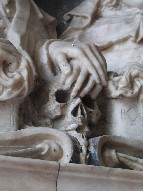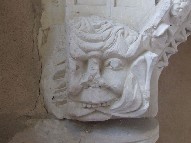| |
|
 |
|
It was the day of the 2008
Historic Churches Bike Ride. We had
planned to wend our way along the border
between Norfolk and Suffolk, but we soon
got fed up with the number of churches in
the northern county which were not taking
part, and so decided to devote the rest
of the day to the friendly, welcoming
churches of northern Suffolk instead (and
I know in which county I'll be leaving my
legacy if I ever win the lottery, folks).
St Nicholas is a big church,
and I had a vivid memory of arriving here
on my bike during a storm some ten years
before. Today was quite different, with
the early September sunshine warming up
the air and filling it with a golden
light. The church is set back from the
road behind a hedgerow, with an open
fallow field beside it. When Pevsner came
this way in the 1960s he found it much
overgrown with ivy, and how handsome that
is, and how rarely one sees it in these
archaeological times! He even noted
that the creepers hung down over the east
window, but today I am pleased to say
that the church has been rescued from the
encroachment of nature. Ivy is no good
for buildings, and no doubt it was
hard-headed thoughts about the cost of
maintenance which led to its removal
rather than anything archaeological.
|
Unusually
for East Anglia, this is a pretty much complete
work of the 14th Century - another good example
is neighbouring Rickinghall Inferior, a church
which has much in common with this one, despite
two very different towers. The bulk of the south
aisle of the nave gives the impression of two
churches sitting side by side. Sam Mortlock
points out that, interestingly, at the time this
aisle was built, the Rector here was Edmund
Gonville, founder of Gonville and Caius College
in Cambridge.
You
step into what is an overwhelmingly Victorian
interior, but with a pleasing rural feel to it.
Such a big church could easily have succumbed to
a soulless, urbanising restoration, but the
architect was Richard Phipson, always a safe pair
of hands, if not exciting ones. The finest
feature, and the one which captures the eye, is
the magnificent east window, its five lights and
bubbly Decorated tracery full of mainly clear
glass which floods the chancel. Mortlock thought
that the remains of medieval glass in the upper
lights was original, and he is probably right.
Contemporary with it is the piscina in the south
aisle, which has been battered over the years,
but still has a surviving green man in the bottom
of the eastern pillar.
St
Nicholas was obviously a shining star in the
Anglo-catholic firmanent in the early years of
the 20th Century, and a few devotional fixtures
survive from that time. The large roundel of the
Flight into Egypt, which is believed to be 18th
Century Italian, was given by the Rector in the
1940s, and there is a statue of the young Christ
preaching in the temple in an elaborate image
niche at the west end. Those days probably also
brought the selction of mid-19th Century Saints
in glass which are set in the east window,
presumably originally from another church.
| Dominating the south wall of
the chancel is the huge mural monument to
Henry Bokenham and his wife. Bokenham
died in 1648, and he sits with his wife
at the top, with their books and a skull.
Their son and daughter sit below. Pevsner
thought that the quality of the monument
is poor, but in fact it injects something
of a note of sophistication into what is
otherwise a pleasantly rustic place. Another
hint of sophistication, perhaps, is that
John Middleton Murray is buried in the
graveyard. The fiercest literary critic
of the middle years of the 20th Century
and the husband of Katherine Mansfield,
he was a friend of DH Lawrence and the
editor of the Atheneum magazine. A
vociferous promoter of High Culture in
the face of increasing relativism, he is
almost forgotten today.
|
|
 |
|
|
|

